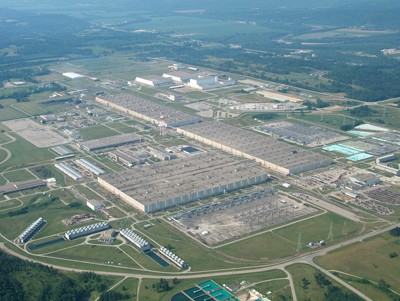Portsmouth Gaseous Diffusion Plant
Introduction
Text-to-speech Audio
Images
An aerial shot of the plant

Backstory and Context
Text-to-speech Audio
The 3,700-acre federal facility was the last of three gaseous diffusion plants built in the United States by the Atomic Energy Commission (AEC), the predecessor agency of the U.S. Department of Energy (DOE). The Portsmouth facility, along with its sister facilities at Oak Ridge, Tennessee, and Paducah, Kentucky, enriched weapons-grade uranium that was used for the nation's nuclear defense program during the height of the Cold War. Later, fuel produced at the Southern Ohio facility was used by the U.S. Navy to power its nuclear subs and the commercial nuclear power industry.
The facility has 2.2 million cubic yards of hazardous waste and 415 contaminated facilities and structures. There are 1.5 million cubic meters of solid waste and 88 million gallons of liquid waste at the facility. There are 5 trichloroethylene contaminated plumes underground that contaminate groundwater and surface water on-site.
The Department of Energy's Office of Environmental Management began an environmental cleanup program at the site in 1989. In 2005, the Department of Energy initiated deactivation of the Portsmouth facility. In 2010, a $2.1 billion contract was awarded to Fluor-B&W to conduct decontamination and decommissioning activities at the facility for over 10 years. The project is expected to end in 2024. The environmental cleanup program is continued today by the U.S. and Ohio Environmental Protection Agencies. Since this project is still being enacted many field trips are taken to this site. During these field trips, the kids learn details about this plant and what is being done to it.
The Portsmouth Gaseous Diffusion Plant has many different buildings and facilities on site. These include process buildings, feed, and sampling facilities, a mechanical testing building, an electrical switchyard, a steam plant, and a shipping and receiving facility. The site also has a cafeteria, administrative building, and a hospital once used for the employees of the plant.
Sources
U.S. Department of Energy. "Virtual Museum Captures Ohio Plant History". 21 May 2012. Web. 02 May 2014. Retrieved from www.energy.gov Flour-B&W/Portsmouth.
"DOE’S GDP Gets Go-Ahead For Final Transfer Of Facilities." 4 October 2011. Web. 02 May 2014. Retrieved from www.fbportsmouth.com
Portsmouth Site, Department of Energy. Accessed October 26th 2019. https://www.energy.gov/pppo/portsmouth-site.
History of the Portsmouth Gaseous Diffusion Plant, Portsmouth Gaseous Diffusion Plant Virtual Museum. Accessed October 26th 2019. http://www.portsvirtualmuseum.org/.
Portsmouth Gaseous Diffusion Plant Virtual Tour, Portsmouth Gaseous Diffusion Plant Virtual Museum. Accessed October 26th 2019. http://www.portsvirtualmuseum.org/virtual-tour.htm.
Portsmouth Gaseous Diffusion Plant Fact Sheet, National Conference of State Legislatures. Accessed October 26th 2019. http://www.ncsl.org/research/environment-and-natural-resources/portsmouth-gaseous-diffusion-plant.aspx.
